Which Survival Food is Best?

Can you rely on government support, especially food and water within 72 hours a major disaster or even within a week? Or during a prolonged economic depression?
Most everyone agrees that we shouldn’t depend on government emergency support. But only 7% have taken action to be prepared, according to the American Red Cross.
What type of food reserve is best for survival preparedness?
I have sorted through the pros and cons of various survival food options below with these needs in mind.
Two options that you may not be as familiar with are MRE (meals ready to eat) and Freeze Dried Food. MRE is what the military uses for mobile activities, but it is available from the same manufacturers as civilian MRE. Freeze dried food is a longer storing type of food reserve that is also used by the military and government agencies as well as campers and backpackers.
Freeze dried food and MRE have long to very long storage life for emergency food reserves and most importantly require little or no preparation, water, and no cooking equipment.
If you take just a few minutes to read below about the advantages and disadvantages of survival food options to make a wiser more well-informed choice.
Survival Food Options
What are the options for food emergency preparedness?
The conventional wisdom offered by our governments and dedicated survivalists is to go to your local supermarket or big box store and buy canned food and dry grains and carefully store them. There are limitations to this survival food strategy that are highlighted below.
Survival Food Option – Buy Canned Food and Dry Grains
Buy the canned foods, grains, and bottled water as many government agencies recommend. Store in your house or apartment.
Advantages
- Can be done in a few hours or less for a 72-hour or one week reserve.
Disadvantages
- Most will forget and some will not store it properly so it will be useless when it is needed. Did you do this years ago? Go look at this food now and check the expiry dates on canned goods and check grains for mold infestations, rodent invasions, etc.
- Canned foods are bulky and heavy, space is often limited people will not be able to store much
- Grains need a lot of water to cook to eat and water may be unavailable or scarce in a disaster.
- You will need to spend a lot of time preparing food
- Canned foods destroy appetites and morale quickly. Even unexpected allergic-type reactions can occur if the types of food in a diet are drastically changed.
Survival Food Option – Buy Canned Food and Dry Grains and use them regularly on an “inventory cycle” plan
Same strategy as the first option, except you, actively manage storing and ‘cycle’ inventory of goods. As you buy new food you use up the old canned food so that the food store is less than the expiry date of the canned food. The main point of this strategy is that you use these items on a regular “inventory cycle” plan.
Advantages
- Food will not be bad when you need it
Disadvantages
- Most people do not have the time, space, or inclination to do this
- Grains need a lot of water to cook to eat and water may be unavailable or scarce.
- You will need to spend a lot of time preparing food
- Canned foods will destroy appetites and morale quickly
Survival Food Option – Buy MRE’s
Advantages
- Easy to store and lasts up to 5-7 years in a cool dry place.
- Easiest and fastest preparation time possible and can be heated fast with “MRE heaters”
- Can be ordered online in minutes, delivered to your house. You will only have to spend less than 30 minutes storing it.
Disadvantages
- Relatively expensive per meal ($6-$7) and for an extended reserve of 6 weeks, 3 months, or a year a lot of space required to store.
- Lasts only 5-7 years so you will need to buy a replacement reserve relatively soon. Hopefully, you do not live in a place where there is a disaster that often.
- Tastes like canned food which will destroy appetites and morale quickly
Survival Food Option – Buy Freeze Dried Food
Advantages
- Easy to store and can last up to 30 years.
- Fast simple preparation just add water. But only water that is needed to hydrate the food, much less than cooking.
- Once hydrated, freeze dried food taste is very close to original food taste.
- Light weight easy to store large qty (Mountain house #10 cans) of food for reserves of 6 weeks, 3 months, or a year. A 6-week food reserve can fit under a bed!
- Can be ordered online in minutes, delivered to your house. You will only have to spend less than 30 minutes storing it.
- Good economical choice – cost can be less than $3.00 per meal.
As you can see there are a lot of benefits to Freeze Dried Food over the other options making it the superior choice as a bulk survival food.
Freeze Dried Food Reserve Packages
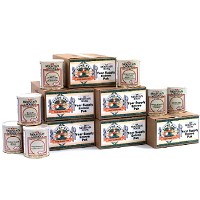 Mountain House 4 person 3-month “dinner Entree-pak”
Mountain House 4 person 3-month “dinner Entree-pak”
True food preparedness means;
- A food reserve with variety that tastes good so people can eat and be satisfied
- Food that is simple and easy to prepare even in a disaster
- Food that is easy to store and transport
The new Mountain House 4 person 3-month “dinner Entree-pak” meets all of these conditions and at a low price per meal.
Priced at $1190 this package offers an affordable peace of mind for preparedness for your family that easy to use.
So you don’t need to be a dedicated trained survival enthusiast to be prepared. You just need to make the right preparedness choice.
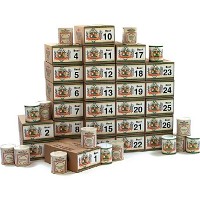
Platinum Food Reserve
Food supports 4 People for 3 Months or one person for a year.
This bulk freeze dried food reserve is (at the time of this post) for $3375, with free shipping and a 120-day ‘no-risk’ guarantee.
“…will provide over 2000 calories per day for one person for one complete year, or a family of 4 for 3 months! It comes with a total of 168 #10 cans (large restaurant size cans) that comes packed in 28 cases for easy storage.”
Available at Nitro-Pak ;
Available at the ReadyStore;
- Freeze Dried Food
- MRE food reserves
- 72 Hour Kits
MRE Information
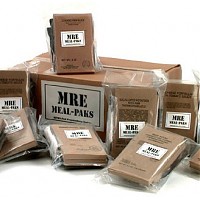
MRE or “Meals Ready to eat” are military-style food rations.
Some reasons why they are a popular choice for survival food;
- MRE’s paks are a complete meal with the main course, side dish, crackers with spread, dessert, and a powdered drink mix.
- MRE packs last 4-10 years depending on storage temperature, longer than most canned food.
- They are pre-cooked and in a pouch “ready to eat”, nothing needs to be added
- Usually, you buy MRE with flameless heaters so you can eat your meal hot (cold is ok too)
USAGE
You can best use MRE for emergency situations where you “are on the go” . Also, if you do not want to waste time cooking or do not want the hassle of bringing cooking equipment with you. MRE’s are the most convenient survival food choice.
MRE’ cost is about $6 – $7 per meal plus shipping for a case of 12. You can get discounts if you buy larger quantities.
MRE cases and food reserves can be found online at The ReadyStore, Nitro-Pak, Emergency Essentials, and other merchants.
For a food reserve for periods longer than a week, however, a “freeze dried food” reserve is better in terms of space and cost per meal. You will need water for freeze dried food which, although hydrates quickly, is nevertheless is not as “ready to eat”
Planning Survival Food – Short and Long Term
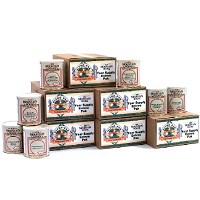
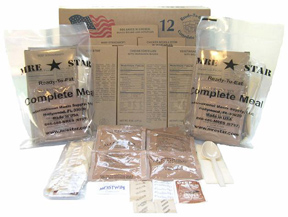 No one preparedness strategy will support all your food needs in a disaster.
No one preparedness strategy will support all your food needs in a disaster.
While there are huge advantages freeze dried food gives as the survival food of choice, it is not the best in all situations. It is good planning to have a short-term strategy and a long-term strategy to be best prepared.
Below is a look at food preparedness strategies, starting with the long term.
Long Term Survival Food Strategy
Long-term here refers to having a food supply that will last from 2 weeks to 3 months or more. Freeze dried food is best for these situations as it can be easily prepared but still have good taste close to the original food. It is important to not add stress to an already stressful situation with a poor tasting food supply.
Freeze dried food avoids this problem as your family can continue eating a healthy diet that has good taste as close to fresh as possible among all the other food options.
You may still want to prepare a herb or sprout garden kit to add a live food source to your reserve. Astronauts who have eaten freeze-dried foods for extended periods have commented on how they relished live fresh food upon their return.
It will be important after a disaster to have as much time as possible available each day for other important activities. You can maximize your available time by not spending a lot of it preparing and cooking food.
Mountain House freeze dried food in #10 cans (which can store up to 25 years) have 8 to 10 servings each and will last up to 2 weeks once opened. #10 cans are an ideal strategy for the long term.
You will need a large enough space to store the lightweight #10 cans of freeze dried food and also water containers. A freeze dried food supply for 3 months for a family of four can store in a space 3′ by 3′ by 4′ high. You will easily be able to transport this if need be in a van or pickup truck from a storage location to a place you will reside during a disaster. But if you want to be able to be mobile with this type of food supply you will need some type of RV.
Daily calorie intake for different freeze dried food packages varies. Planning 1500 calories a day would be the bare minimum for an adult, even for someone less active. 2100 to 2400 calories is recommended. If you want to plan for support of very active adults you may want to add extra meals to bring the daily total to 2900 calories per day. Small children 5 -9 years old will require about 700 – 800 calories per day.
A water supply of 3 months for a family of four would require is about 440 gallons or eight 55 gallon drums. This will provide a gallon of water each per day for 110 days. You can get food grade storage drums that will safely store water for 5 years. You may have plans for an alternative supply of water in a long term situation and not require all eight of the drums.
Short Term Survival Food Strategy
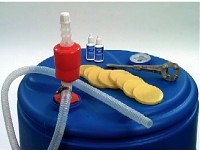
For initial disaster preparedness food supply, MRE (meals ready to eat) are a better choice. They do not require water to hydrate, they are truly ready. They can be heated in 10 minutes with “flameless ration heaters” a pouch that will heat up if you add a little water to it.Short Term Survival Food Strategy
MRE’s are great if you want to spend as little time preparing and eating food as possible. This will especially be the case shortly after a disaster where you may need to travel or expend a lot of effort to recover get set up and be prepared for the long term.
One drawback of MREs is that many people are critical of the taste and some report difficulty digesting the food. You should try MRE with your family to make sure no one has a strong dislike for it. It will also be helpful for them to know what to expect in terms of food before a disaster.
The other drawback for MRE is that it is twice as expensive as freeze dried food per meal.
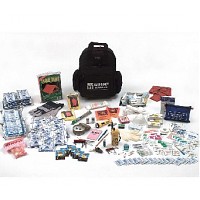 For these reasons, I recommend planning MRE supply for a maximum of 3 weeks. After that, you should be ready to use your long term freeze dried food supply regularly for you food needs. Since MRE lasts only 5-7 years you may want to safely plan to re-stock it ever 4 years when there is an election or when there is an Olympics to help you remember. You want to make sure at this time that the MRE agrees with everyone.
For these reasons, I recommend planning MRE supply for a maximum of 3 weeks. After that, you should be ready to use your long term freeze dried food supply regularly for you food needs. Since MRE lasts only 5-7 years you may want to safely plan to re-stock it ever 4 years when there is an election or when there is an Olympics to help you remember. You want to make sure at this time that the MRE agrees with everyone.
Keeping bottled water cases stocked up will help be prepared for the short term, however for longer than 2 weeks you really need to consider storage drums or some other alternative source to be prepared.
Finally, it would be a good idea to keep a 72-hour kit with food bars or MRE in your car(s) so that you and your family will have support need to get back together if you are separated when disaster strikes.

someone was helping to can beans and didn’t put enough water in to cover the beans and now some of the lids are loose. Do we have to recan them, take them out and freeze them, or throw them out completely?
Thank you,
Hi Rose,
Sorry I am not an experienced canning person. Try a Google search on “canning mistakes” or “canning errors”.
Anyone else have advice?
CANNING
If the lids are loose the food is spoiled, dispose of it. You probably didn’t get the cans hot enough for the lids to seal so really all the food should be suspect. NOT HOT = DIDN’T KILL BACTERIA. No the water does not need to completely cover the beans for the canning to be good but they will discolor and look unappetizing, you can always take off the top layer and eat the ones off the bottom. This is a good habit to be in anyway when canning fruits and jellies.
Is it okay to store MREs in the garage where it gets very cold in the winter and very hot in the summer?
Very Cold – If you are in climate where the temperature in the garage will get below freezing so that the MRE gets frozen, the answer is it is not OK. Foods that contain meat should not be frozen thawed and re-frozen, it can make you ill. Freezing MRE once will not make it go bad, but it will degrade the nutritional value as much as 50% or more.
Very Hot – if you are in a climate where the temperature in the garage goes over 80 degrees Fahrenheit then the high temperatures will greatly diminish the shelf life of the MRE.
At 120 degrees storage temperature the MRE shelf life is only about one month,
at 100 degrees it will last almost 2 years,
at 80 degrees Fahrenheit, MRE shelf life will be over 6 years
below 70 degrees MRE shelf life will be 8-10 years.
So storing it in a garage for a few months one summer where daytime temperatures are over 100 degrees could make it go bad. It is better to store it in a basement rather then an un-air conditioned garage.
If you go on vacation and the basement temperature gets above in worst case 90 degrees for a few days it won’t significantly impact the shelf life of the MRE, as long as it not exposed to high temperature for months you can expect it to have at least 5 year shelf life if the temperature is below 80 degrees most of the year.
I need to know who is selling 100 Gallon water water barrows???? If not you who?
Hi Robert,
Tank Depot has 100 gallon water tanks for $105.73 at the time of this post, the link is below;
http://www.tank-depot.com/product.aspx?id=123
Watertanks.com has a PCO tanks that can be set up outdoors, for $214.29 at the time of this post;
http://www.watertanks.com/products/0300-010.asp
Nitro-Pak has a 4 X 55 Gallon barrel kit that contains;
* Included items: 4 – 55 Gallon Water Barrels
* 1 – Siphon/Manual Hand Pump
* 2 – 5 Year Water Stabilizer (Oxystabile/Aerobic 07)
* 1 – Aluminum Bung Wrench (for opening & seal barrel caps)
* 8 – Protective Seal Caps (protects caps from dirt & debris)
Features
No water rotation for 5 years!
Everything you need including 4 – 55 gallon water containers and 5 year Water Stabilizer!
Nitro-Pak 4 X 55 Gallon barrel kit
do you use BPA to can your survival food? please inform before I consider buying off this site.
thank you!
Once opened, how long do the #10 cans keep?
Hi Steve,
Mountain House #10 cans will have a shelf life of 2-3 weeks once opened.
Do you sell your food products wholesale?
Thanks,
Joy
Hi Joy,
I do not sell products. I write about survival food in this blog.
I have affiliated partners that are distributors of survival food but not wholesalers.
You can ask Mountain House foods (freeze dried) or MRE Star brand MRE and inquire about wholesale relationships.
Just my two cents but at slightly over 8 pounds per gallon, the 100 gallon storage tank is going to weigh in at least over …800 pounds plus the tank weight itself which could be over 40 pounds or greater since it has to be constructed to contain 800 pounds of water weight and then there’s the associated risk of momentum from shaking ie; earthquake and restraining the 800 pound drum. Since you don’t want this exposed to the elements it’ll probably be indoors and on the ground floor; its going to take up some space (imagine a typical family sized 40-60 gallon water heater minus some wall insulation (about 1-2 inch radial or 4 inches diameter) and double it. Plan on not moving it when you need to draw from it and plan on securing it in the most out of the way place that dosen’t place anyone at risk if it should start moving. I’m using “Reliant” brand 7 gallon or 14 gallon containers (typically from sports stores like REI) because I can stack them, rotate them, and they are designed to take a screw-on PUR type filter cartridge at the outlet as an option. Prehaps “Kelvin (Aug 08)” has greater needs for one large station of water but I wanted to add those 2 cents.
Allen
“I’m using “Reliant” brand 7 gallon or 14 gallon containers (typically from sports stores like REI) because I can stack them, ”
Could you please provide a link, i searched and could not find it.
Thanks
Mike
Mike,
I checked the correct spelling is “Reliance” there are 2 types of 7 gallon containers at REI, with (Lifegaurd) and without a filter.
Reliance LifeGuard Container – 7 Gallon
Reliance Aqua-Tainer – 7 Gallon
What is shelf life for:
Perfect Host freeze dried product
information printed on bottom on can
99133N 30-138 MIX 5-7 PRW 08:35
We purchased 20 cases of assorted meals, 10-6-1999
thank you for your help.
Hi Harvey,
I have not seen “Perfect Host” brand of freeze dried food before. I did a search and found some indication it was a brand by Oregon freeze Dry but I can’t confirm if this information is correct.
The shelf life is dependent on how it was packaged. Mountain House for example make backpacking pouches of freeze dried meals. In this packing the shelf life is only 8 years.
However when the same freeze dried food from Mountain House is packed in #10 cans that are carefully flushed with Nitrogen so there is no oxygen when the cans are sealed, will last up to 25 years according to Nitro-pak.
Below is an example of a “date code” found on Mountain House freeze dried food;
1989 and after:
EXAMPLE: 99028 CIA
99 = Year
028 = Julian Date (example = 28th day of the year = January 28)
CIA = Production Operator’s Initials
If your “Perfect Host” freeze dried food uses a similar system the 99133N could mean 1999, day 133, which would be eary May of 1999.
This could mean when it was packed. However this is not an expiry date. You would need some more information from the manufacturer on shelf life as knowing when it was packed is good info but it does not tell you the shelf life.
Sorry I could not be more helpful.
The only other suggestion I have is call Mountain House (Oregon Freeze Dry) customer service and ask if the produced this brand of freeze dried food and if so what the shelf life is. The customer service number for Mountain House is 1-800-547-0244 if you are calling from the US. You can also email them from this page;
http://www.mountainhouse.com/contact.cfm
Hi, my husband and I have been building up a supply of food for about 8 years. After Hurrican Ivan hit and left us with nothing we had to start over. Red Cross didn’t get to us for over a week, when the miltary came in they passed out mre’s and water. We ate the mre’s and going on the second week I was having trouble getting them down. I found it very hard to contiune eatting them. When we finally found a home (8 mths later) we had been lucky enough to have a whole lot of space (we had to start over). We purchased freezed dried #10 canned ( Honeyville) of veggies (onion, carrot, celery, peas, corn, potatoe flakes) fruit (strawberries, apples, peaches, rasberries, blue berries, bananas), eggs (egg whites, egg yolks, whole egg). I filled the pantry with alot of things like Olives, large can chicken, tuna, #10 canned tomates, chili, all kinds of canned fruit, baked beans, our thing was we need enough for family, our animals and neighbors. We buy rice in 50lb bags and we vacuum seal gallon size amounts along with oxygen removers (this is very important), we do this for noodles, sugar, flour, grits, dry milk, etc… Next is the beans, every kind, beans go along way we put them in a quart size zippie bag and again we vacuum seal with oxygen removers. We stocked up on everything we use from bathroom supplies, toliet paper, toothbrushes, soap, shampoo, etc… to cases of canned bread (special order) & cases of canned butter (special order) I think you get the point. We vacuum seal everything but the cans. I have everything we need to enjoy our meals. I bought Bulk Foods (sams club & other stores that sell the #10 cans). We have the convenice of not needing to go shopping for 7-10 years. Since we lost everything we started over with furniture, we did not buy any end tables, etc.. instead we bought those nice big blue buckets with lids. I have stacked (2 high) 8 full containers behind my sofa (the fit was perfect just under the full lengh of the sofa) my husband cut a pcs of plywood to fit the top next I put a nice cover (sheet) over it and put some nick nacks on top so you don’t even know its there, did the same thing with the love seat and my end tables are containers. When our pantry was loaded and my laundry room cabinets where full I had to put the food some place. I also use a dehydrator for jerky and fruit (short term). For the question about how would we move this if we had to move no problem, because of Hurrican Ivan we had to purchase an RV (30′) it would be easy to move these items into the RV. Anything major hits us either by Mother nature or by Man we have our list, Animal & Things (every day items), Medication, Cleaning Supplies, Emerg 1st Aid, Emerg 1st Aid for snake bites, bathroom items, Lots of Bleach, Food, Water Purifiers (2), Rechargeable Batteries, Extra Gas, Elec & Duct Tape, Flash Lights & Lanterns, Propane, Propane Heater, RV and/or Tent & Supplies, Tools, Solar Panel, Camouflage Clothes & Nets, Generator, Oil/Gas, Candles, Matches, Batteries AA, AAA, D’s, C’s,
Extra Water Filters for Purifier, Entertainment (brd games, dice, cards etc…), Protection (ect….). We do expect the worse to happen and I have an evacuation plan list that we sent out to our close friends and family that is more detailed (a place to meet up, road maps that are marked and several ways to get where we need to go. Some people may think this is really bad but thats okay because there are a whole lot of people like us doing the same thing (food for thought).
Just a note of information.
Repeated freeze/thaw cycles of MRE’s do not cause them to become ‘dangerous’ it does ruin the flavor.
MRE’s are salty and high calorie/low residue food designed for a very active environment to keep your water usage down and prevent you from having defecation problems (diarrhea). Extended use will cause constipation in many people.
MRE’s life expectancies are from the US military, and are determined not by quality or safety, but by the time at which no one will eat them–they still have food value long after their ‘expiration date.”
DO NOT BUY “surplus” MRE’s which come from the military. You have no idea how they have been stored and if it was in the desert, they are probably not very good for flavor.
Storing anything in a relatively constant low temperature <50 F and constant low humidity will preserve materials the longest.
Canned goods expiration dates are not a fixed thing either! The dates are calculated based upon average storage and is quite conservative as it is primarily determined by the probability of a lawsuit.
The American Canning Association has been opening a can annually from a batch canned in the late 1800’s and have had only a few cans spoiled.
Cans should be checked annually for bulging or rust. Bugling cans should be discarded (botulism) and rusted cans that are intact should be used.
Modern dry foods are usually packed these days (since about 2000) with an oxygen absorber (that little packet that says “do not eat”) and last much, much longer than previously. Expiration dates on these are also primarily based upon legal matters.
Remember to store things based upon the most likely events you will face–don’t put your survival stuff on the ground or below ground level if you are in a flood zone!
Water filtration equipment is much easier to store than water, and is probably the way to go if you live in areas which get rain and have surface water year-round. You can use a transparent plastic sheet to evaporatively distill water outside (check the desert survival sites.) This permits you to use urine and suspect water sources. If you are without water entirely, urine from healthy people is sterile and can be used for wound washing and drinking.
This is in addition to some bottled water supplies. You need from 1qt to 1 gallon per/person/per/day depending upon the weather.
DO NOT CONFUSE “Sell buy” dates with “expiration” dates! Most fresh foods are good for several days after the “sell by” date, longer if frozen or otherwise stored properly.
Even “expiration” dates aren’t a fixed item and usually mark the end of the period in which the manufacturer will guarantee flavor–not food value.
It’s a good idea to coordinate things with your neighbors so that you can be of organized assistance to each other during an emergency, emergency personnel are spread very thinly, anyone who is capable of taking charge of a situation should not wait for the emergency services to show up–remember the people sitting in the sun on the freeway in New Orleans after Katrina, who, despite having access to lots of material, didn’t even build shade for themselves?
Humans are fairly weak on their own, our greatest strength is our ability to cooperate. This can only be done if you remain rational and relatively calm.
Truly, united we stand, divided we fall.
And TRAIN! Train your family, train with your neighbors, work with your emergency government coordinators.
It has been shown that people in an emergency will do what they have trained to do. People who have no “built-in” model of what to do in a situation tend to stand around and wait for instructions. This can be fatal.
The more training you have for different events, the faster and more appropriate your actions will be in a real emergency. There is a good reason that emergency personnel train so much.
Don’t write injured people off! Humans are both much tougher and more delicate than you can imagine. I know a man who at 65 slipped with his chainsaw and sliced off a big chunk of face and arm–then drove 30 minutes to the hospital all on his own. (Granted, it wasn’t very smart to be using a chainsaw in the forest on his own….)
Take first responder training, or at least basic first aid. Red Cross offers courses everywhere for reasonable prices.
Remember, Life is everything, “valuables” are not worth risking your life. Don’t go into a damaged building unless you know it is still structurally sound–that gold won’t help you if you have the house fall on you! I love my pets, but I won’t risk my life for them. If you have pets, have carriers and emergency supplies for them too. And it is especially important to train for evacuation with them so that they don’t get overly excited (irrational). It’s bad enough to have to deal with rising water without having your dog try and play or be scared and biting at you!
When in doubt, stop, breathe, and think before acting!
In most situations, you have time to spend a few seconds thinking and it is better to do the right thing than to act rashly and do the absolutely wrong thing. A 5 seconds is a LONG TIME if you are thinking. (Don’t think so? Have a friend time you on a watch, and estimate for yourself when 5, 10, 30, and 60 seconds have passed. You will probably come up short.)
Do not count upon your electronics, they can easily be damaged and not function. A cell phone is only as good as the infrastructure supporting it. When listening to your emergency radio, remember that for your particular location, YOU are the expert on how things are going. The radio may be very far from reality, especially early in an event.
The first hours of any emergency are the most important to prepare for as that is the time you are least able to expect assistance from emergency personnel.
Stay calm, act rationally, keep your spirits up. People who die in the aftermath of an emergency do so in many cases because they gave up hope. Do not panic! Panic often kills not only the panicked, but others as well.
If, as many of us are, you are on medication, have several days of dosages in your emergency kit (remember to rotate them at least monthly to keep them fresh!)
If you have a chronic problem (diabetes, organ transplants, heart problems and such,) have and WEAR a medic alert tag of some sort.
Have a list of your medications, dosages, prescription numbers, doctors and such on you at all times. This will, in everyday life, speed up and increase the accuracy of any medical assistance you need–the first thing the nurse does is find out what meds you are on, having them written down ensures that the information is correct and complete!
Bug your pharmacy if they cant give you a printout on one or two pages with all of your prescriptions. They will probably tell you they cannot do it. This is not true. Every pharmacy software company says that such a report can easily be generated.
If everyone had this information available, it would save billions of dollars in appointment time which is currently used to transfer this information to the nurse–time that can be used to diagnose what is wrong with you! The savings due to having a complete and correct list of meds may be your life!
Prepare for the worst scenarios and the lessor ones will be handled.
Hi Charles,
Amazing comment thank you for all the advice and input, some of the best I have seen anywhere.
Regarding freezing of MRE please note this comment on MRE packaging from the military “Defense Supply Center Philadelphia” at bottom of page 2 of the pdf at this link;
http://www.dscp.dla.mil/subs/support/qapubs/appa/m1d.pdf
“One of the primary problems with the pouch is that it is prone to puncture by sharp objects both from external sources (e.g., grains of sand, gravel, twigs) and from internal sources (e.g., ice crystals of frozen product.”
Thank you for this information. My husband just saw me looking at Homeland Security’s disaster preparedness website and said “paranoid?”. I am glad to see so many other like minded people interested in protecting their families. I see that I have a lot of work to do. The Department of Homeland Security’s website seems to only cover the tip of the iceberg.
When determining the amount of water needed per person per day, should we add to that amount if we are planning on using the dehydrated food?
Hi Paige,
Paranoid – no, wisely prepared – yes.
FEMA recommends one gallon (128 fluid ounces) of water per person per day for their 72 hour preparation kit. That includes a bare minimum for drinking, hygiene, and cooking. But you don’t need to cook freeze dried food. Hot water is all you need if you want a hot meal, but boiling water is not required to eat freeze dried food.
Freeze dried food has 98% of the water removed. However all of the water added for re-hydrating the food is consumed by you when you eat the food, unlike cooking, so there is no difference on average with the amount needed if you had to cook a typical meal probably less.
You also need some drinking water in addition to your food, budget about 32 ounces per day if you are mostly indoors and double that if you expect to be mostly outdoors.
My recommendation is for 1.5 gallons per person per day, so you have a reasonable amount for hygiene if you are preparing for longer periods of 3 months or more, especially if you have the storage space.
It is always helpful to have either water purifiers, filters, or tablets to augment your supply of water or in case you need to travel.
The choices depend on types of water sources available in your geographical area.
A viable consideration for emergency food is which retains more nutritional value, MRE or Freeze Dried? Another consideration for Freeze Dried is the amount of water required to re-hydrate when in an emergency may be limited.
What are the concerns if you have a well dug and a hand pump to pump water? will the water supply be ok to use in a disaster situation? Any precautions?
Hi Tracey,
I am certainly not an expert on well water and suggest you Google “well water safety”. You should be concerned about bacteria, particulate, and chemicals. Water filters can address most of these issues but I suggest you have the well water tested.
Hi, My husband does not like me to stock up but we lost EVERYTHING in Katrina and moved to a place where I now have to be afraid of tornadoes and earthquakes. We live on a fault line in the upper Arkansas and Tennessee area. Now instead of water, I have to worry about the ground opening up or wind taking my house in less then 5 minutes. We do not have a basement or underground area where things could be stored. What would you suggest for a survival plan? Thank you for your time and help.